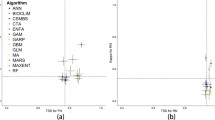Abstract
When a new relevé is to be assigned to a pre-existing type, its composition is compared with an association table. Bayesian inference may seem a good way to make the comparison, but presents difficulties. In an alternative approach, three indices of goodness-of-fit are proposed. Compositional satisfaction is a measure of how well the species composition of the relevé fits the constancy classes in the table; it is a minor modification of the Czekanowski coefficient of similarity between observed and expected numbers of species in each constancy class. Dominance satisfaction is a modification of the Czekanowski similarity between the relevé and cover values that might be expected from the association table. Dominance constancy is a weighted mean of the constancy class of the four most abundant species in the relevé. A computer program, TABLEFIT, combines them into a single index. It has been tested on British mire vegetation.
Similar content being viewed by others
References
CurrallJ.E.P. 1987. A transformation of the Domin scale. Vegetatio 72: 81–87.
DigbyP.G.N. & KemptonR.A. 1987. Multivariate analysis of ecological communities. Chapman & Hall, London.
GauchH.G. 1980. Rapid initial clustering of large data sets. Vegetatio 42: 103–111.
GoodallD.W. 1966. Deviant index-a new tool for numerical taxonomy. Nature 210: 216.
HillM.O., BunceR.G.H. & ShawM.W. 1975. Indicator species analysis, a divisive polythetic method of classification, and its application to a survey of native pinewoods in Scotland. J. Ecol. 63: 597–613.
McVeanD.N. & RatcliffeD.R. 1962. Plant communities of the Scottish Highlands. Her Majesty's Stationery Office, London.
NobleI.R. 1987. The role of expert systems in vegetation science. Vegetatio 69: 115–121.
OrlóciL. 1978. Multivariate analysis in vegetation research. 2nd ed. Junk, The Hague.
PankhurstR.J. 1975. Identification by matching. In: R.J.Pankhurst (ed.), Biological identification with computers, pp. 79–91. Academic Press, London.
Rodwell, J. 1986–7. The National Vegetation Classification: Mires. University of Lancaster, unpublished report to the Nature Conservancy Council.
RodwellJ. 1988. The National Vegetation Classification: almost there! Bull. Br. Ecol. Soc. 19: 75–77.
SealH.L. 1964. Multivariate statistical analysis for biologists. Methuen, London.
SneathP.H.A. & SokalR.R. 1973. Numerical taxonomy. W.H. Freeman, San Francisco.
SpiegelhalterD.J. & Knill-JonesR.P. 1984. Statistical and knowledge-based approaches to clinical decision-support systems, with an application in gastroenterology. J. Roy. Statist. Soc. A. 147: 35–77.
ter BraakC.J.F. 1986. Interpreting a hierachical classification with simple discriminant functions: an ecological example. In: DidayE. et al. (eds), Data analysis and informatics, IV. pp. 11–21. Elsevier, Amsterdam.
van derMaarelE., JanssenJ.G.M. & LouppenJ.M.W. 1978. TABORD, a program for structuring phytosociological tables. Vegetatio 38: 143–156.
WesthoffV. & van derMaarelE. 1973. The Braun-Blanquet approach. In: WhittakerR.H. (ed.), Ordination and classification of communities, pp. 617–726. Junk, The Hague.
Author information
Authors and Affiliations
Rights and permissions
About this article
Cite this article
Hill, M.O. Computerized matching of relevés and association tables, with an application to the British National Vegetation Classification. Vegetatio 83, 187–194 (1989). https://doi.org/10.1007/BF00031691
Accepted:
Issue Date:
DOI: https://doi.org/10.1007/BF00031691




